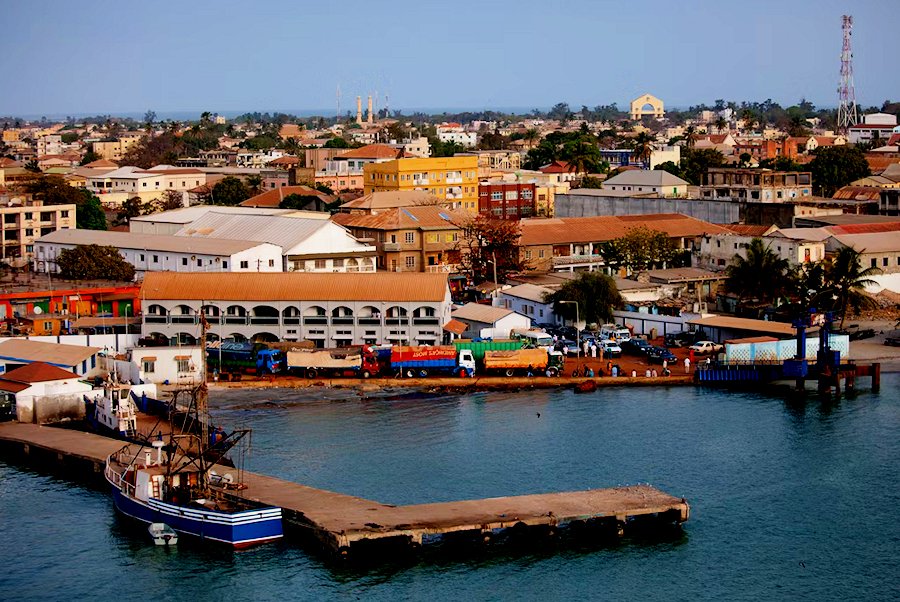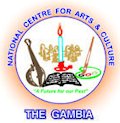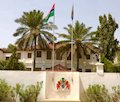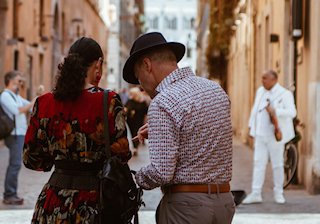Travel Notes: Destinations: Africa: The Gambia - Banjul Travel Guide.
Short URL: https://tnot.es/BJL
Travel Guide For Visitors to Banjul
Discover the smallest capital city in West Africa, where colonial architecture meets vibrant markets, and the mighty Gambia River flows into the Atlantic Ocean. Share on Facebook
Small Capital - Large Character
Nestled on St Mary's Island at the mouth of the Gambia River, Banjul might be one of Africa's smallest capitals, but what it lacks in size, it more than makes up for in character.
Visitors to Banjul can explore landmarks such as Arch 22, a historical monument and museum, as well as the African Heritage Museum.
 Add a Business -
Add a Location -
Add a Lodging - Add Travel Content
- Add URL
- Travel Services.
Add a Business -
Add a Location -
Add a Lodging - Add Travel Content
- Add URL
- Travel Services.
Banjul Operates at its Own Delightfully Unhurried Pace
The port city of Banjul serves as a perfect introduction to The Gambia's rich cultural tapestry; offering visitors an authentic slice of West African life without the overwhelming crowds of larger capitals.
Here, you'll find government buildings sharing streets with spice-scented markets, colonial-era architecture standing proudly alongside modern developments, and locals who greet visitors with genuine warmth rather than tourist-focused sales pitches.
Getting Your Bearings in Banjul
Where Exactly Is Banjul?
Banjul sits strategically at the western tip of The Gambia, where the Gambia River meets the Atlantic Ocean.
The city occupies the entire St Mary's Island, connected to the mainland by bridges and ferries.
Its compact size means you can easily explore the main sights on foot, though shared taxis and horse-drawn carts add to the local transport mix.
The city's grid layout makes navigation straightforward; most attractions cluster around Independence Drive and the waterfront areas.
Banjul International Airport (BJL) lies about 20 kilometres away in nearby Yundum, making the capital easily accessible for international visitors.
Best Time to Visit Banjul
The optimal time to explore Banjul runs from November through April, during the dry season when temperatures hover around a comfortable 24-30°C.
This period offers clear skies, minimal rainfall, and pleasant evening breezes from the Atlantic.
Avoid the rainy season (May to October) unless you don't mind dodging downpours and dealing with increased humidity.
However, the wet season does transform the landscape into lush greenery and brings fewer crowds to major attractions.
Must-See Attractions and Landmarks
Arch 22 - Banjul's Modern Monument
Standing 35 metres tall, Arch 22 dominates Banjul's skyline and commemorates the 1994 military coup that brought former President Yahya Jammeh to power.
Whilst the political significance remains contentious, the arch offers spectacular panoramic views of the city and surrounding areas from its observation deck.
The climb to the top involves several flights of stairs, but the reward includes sweeping vistas of the Gambia River, Atlantic coastline, and the sprawling city below.
The small museum inside provides context about Gambian history, though exhibits can feel somewhat dated.
National Museum - Cultural Heritage Unveiled
Housed in a striking colonial building, the National Museum of The Gambia showcases The Gambia's rich cultural heritage through well-curated displays of traditional crafts, musical instruments, and historical artefacts.
The ethnographic collections particularly shine, offering insights into the diverse ethnic groups that call The Gambia home.
Don't miss the natural history section, which features local wildlife specimens and geological displays.
The museum's peaceful courtyard provides a welcome respite from Banjul's bustling streets, complete with traditional architectural elements and local artwork.
State House and Government Quarter
The imposing State House, with its distinctive white facade and red roof, serves as the presidential palace and seat of government.
Whilst tours aren't typically available, the building's colonial architecture and manicured gardens make for impressive viewing from the street.
The surrounding government quarter features several other significant buildings, including the Supreme Court and various ministry offices, all showcasing the blend of colonial and modern architectural styles that characterise central Banjul.
Markets and Shopping Experiences
Albert Market - The Heart of Commerce
Albert Market pulses with the energy of daily Gambian life, offering everything from fresh produce and spices to traditional textiles and handcrafted souvenirs.
This sprawling market complex operates as the city's commercial hub, where locals shop for essentials and visitors can find authentic crafts.
Navigate the maze of stalls selling vibrant tie-dye fabrics, hand-carved wooden masks, and aromatic spices like baobab powder and bissap (hibiscus).
Bargaining is expected and part of the experience; start at roughly half the quoted price and negotiate respectfully.
The market's food section showcases incredible local produce, including exotic fruits, fresh fish from the Atlantic, and traditional ingredients used in Gambian cuisine.
The sensory overload of colours, sounds, and aromas makes Albert Market an essential Banjul experience.
Craft Markets and Artisan Workshops
Beyond Albert Market, several smaller craft markets specialise in hand-made goods produced by local artisans.
The Senegambia Craft Market, whilst technically outside Banjul proper, offers high-quality woodcarvings, jewellery, and textiles in a more tourist-friendly environment.
Look for workshops where you can observe skilled craftspeople creating traditional items like djembe drums, leather goods, and intricate beadwork.
These interactions provide cultural insights whilst supporting local economies directly.
Culinary Adventures in Banjul
Traditional Gambian Cuisine
Banjul's food scene centres around hearty, flavourful dishes that reflect the country's agricultural abundance and coastal location.
Rice serves as the foundation for most meals, often accompanied by richly spiced stews and fresh fish from the Atlantic.
Domoda (groundnut stew) ranks as the national dish, typically served with chicken, beef, or fish in a rich peanut-based sauce.
Benachin (jollof rice) offers another staple, cooked with vegetables, meat, and aromatic spices that create layers of complex flavours.
Fresh Seafood
Fresh seafood features prominently, with yassa (marinated fish or chicken with onions and lemon) providing a tangy contrast to heartier stews.
Street Food
Street food options include akara (black-eyed pea fritters) and tapalapa (local bread) served with various accompaniments.
Where to Eat in Banjul
Nefertiti Restaurant serves authentic Gambian cuisine in a relaxed atmosphere, with particularly excellent fish dishes and vegetarian options.
The outdoor seating area provides pleasant evening dining with gentle Atlantic breezes.
For street food experiences, explore the vendors around Albert Market and Independence Drive, where you'll find fresh fruit juices, grilled meats, and traditional snacks at bargain prices.
Cultural Experiences and Local Life
Music and Performance
The Gambia's musical heritage runs deep, with traditional rhythms and modern influences creating a vibrant contemporary scene.
Banjul hosts regular cultural performances, particularly during festivals and special occasions.
Visit local venues where traditional kora (21-stringed harp) players perform alongside modern musicians.
The instrument's melodic tones provide the soundtrack to many Gambian celebrations and cultural events.
Sabar drumming and dance performances offer energetic cultural experiences, with skilled drummers creating complex rhythms that inspire spontaneous dancing.
Many hotels and cultural centres host regular performances open to visitors.
Religious and Cultural Sites
The Great Mosque of Banjul stands as an important religious landmark, featuring striking Islamic architecture and serving the city's significant Muslim population.
Visitors can admire the exterior and learn about Islamic practices in The Gambia, though non-Muslims should respect prayer times and dress codes.
Several smaller mosques throughout the city showcase different architectural styles and community approaches to Islamic worship.
The diversity of designs reflects the various ethnic groups that contribute to Banjul's cultural landscape.
Practical Travel Information
Banjul Accommodation Options
The Laico Atlantic Hotel (Marina Parade) provides Banjul's most upscale accommodation, with modern amenities, Atlantic views, and proximity to major attractions.
The hotel's restaurant serves both international and local cuisine.
Budget travellers can find basic but clean guesthouses throughout the city, many offering authentic local experiences and opportunities to interact with Gambian families.
Tourist Map of Banjul
Use the Tourist Map of Banjul to help you decide where to stay in Banjul based on travel budget, preferred location, planned must-see attractions and local must-do activities.
Getting Around Banjul
Banjul's compact size makes walking the most practical option for exploring central areas.
Shared taxis, known locally as 'gele-gele', provide affordable transport for longer distances; typically costing 10-20 dalasi per journey.
Horse-drawn carts still operate in some areas, offering a uniquely traditional transport experience.
Private taxis can be hired for day trips or more comfortable city touring, though negotiate prices beforehand.
Money and Budgeting
The Gambian dalasi (GMD) serves as the local currency, though euros and pounds sterling are widely accepted in tourist areas.
ATMs are available but can be unreliable, so carry cash for most transactions.
Budget around £20-30 per day for basic expenses including meals, local transport, and market purchases.
Mid-range travellers should think about £40-60 daily, whilst luxury experiences might cost £80+ per day.
Bargaining is expected in markets but not in established restaurants or hotels.
Credit cards are accepted in upscale establishments but cash remains king for most transactions.
Day Trips and Nearby Attractions
Abuko Nature Reserve
This 105-hectare reserve protects gallery forest and savannah habitats just 30 minutes from Banjul.
Well-maintained trails wind through diverse ecosystems supporting over 250 bird species and various mammals including monkeys and antelope.
The reserve offers excellent wildlife photography opportunities and peaceful nature walks.
Early morning visits provide the best wildlife viewing when animals are most active.
Juffureh and Albreda
These historic villages, about 30 kilometres from Banjul, gained international recognition through Alex Haley's 'Roots' novel.
Juffureh allegedly represents Kunta Kinte's ancestral home, whilst Albreda served as a colonial trading post.
The Roots Museum in Albreda provides historical context about the trans-Atlantic slave trade and its impact on West African communities.
River tours can be combined with village visits for a comprehensive cultural experience.
Kachikally Crocodile Pool
Just 15 minutes from Banjul, this sacred site houses dozens of Nile crocodiles in a small pool considered holy by local communities.
Visitors can observe these impressive reptiles up close and learn about their cultural significance in Gambian traditions.
The site includes a small museum explaining crocodile behaviour and conservation efforts.
Local guides share fascinating stories about the crocodiles' role in traditional beliefs and fertility rituals.
Final Thoughts on Visiting Banjul
Banjul rewards visitors who approach it with realistic expectations and genuine cultural curiosity.
This isn't a destination for luxury shopping or five-star dining, but rather a place where authentic West African urban life unfolds at a human scale.
The city's greatest asset lies in its people; friendly, welcoming locals who take pride in sharing their culture with respectful visitors.
Whether you're bargaining in Albert Market, climbing Arch 22, or simply watching daily life unfold from a street-side café, Banjul offers genuine encounters with contemporary African culture.
Plan at least two full days to explore properly, though many visitors find themselves extending their stay to soak up the relaxed atmosphere and forge connections with local communities.
Banjul serves as an excellent base for exploring other attractions in The Gambia whilst providing an authentic taste of this remarkable country's capital city charm.
More City Travel Guides
City Guides: Cities in Africa - Cities in America - Cities in Asia - Cities in Australasia - Cities in Latin America - European Cities and Regions.
More From Travel Notes
Travel Notes Online Guide to Travel
Africa - Asia - Caribbean - Europe - Middle East - North America - Oceania - South America.
The Travel Notes Online Guide to Travel helps visitors plan their trip with country and city travel guides, local tourist information, reviewed web sites, and inspiring travel content.
Travel and Tourism Guides on Travel Notes
 If you find Travel Notes useful, please take a moment to
like us on Facebook and share with your friends on social media.
If you find Travel Notes useful, please take a moment to
like us on Facebook and share with your friends on social media.
Share on Facebook
Travel Resources
.
Travel & Tourism With Industry Professionals.














